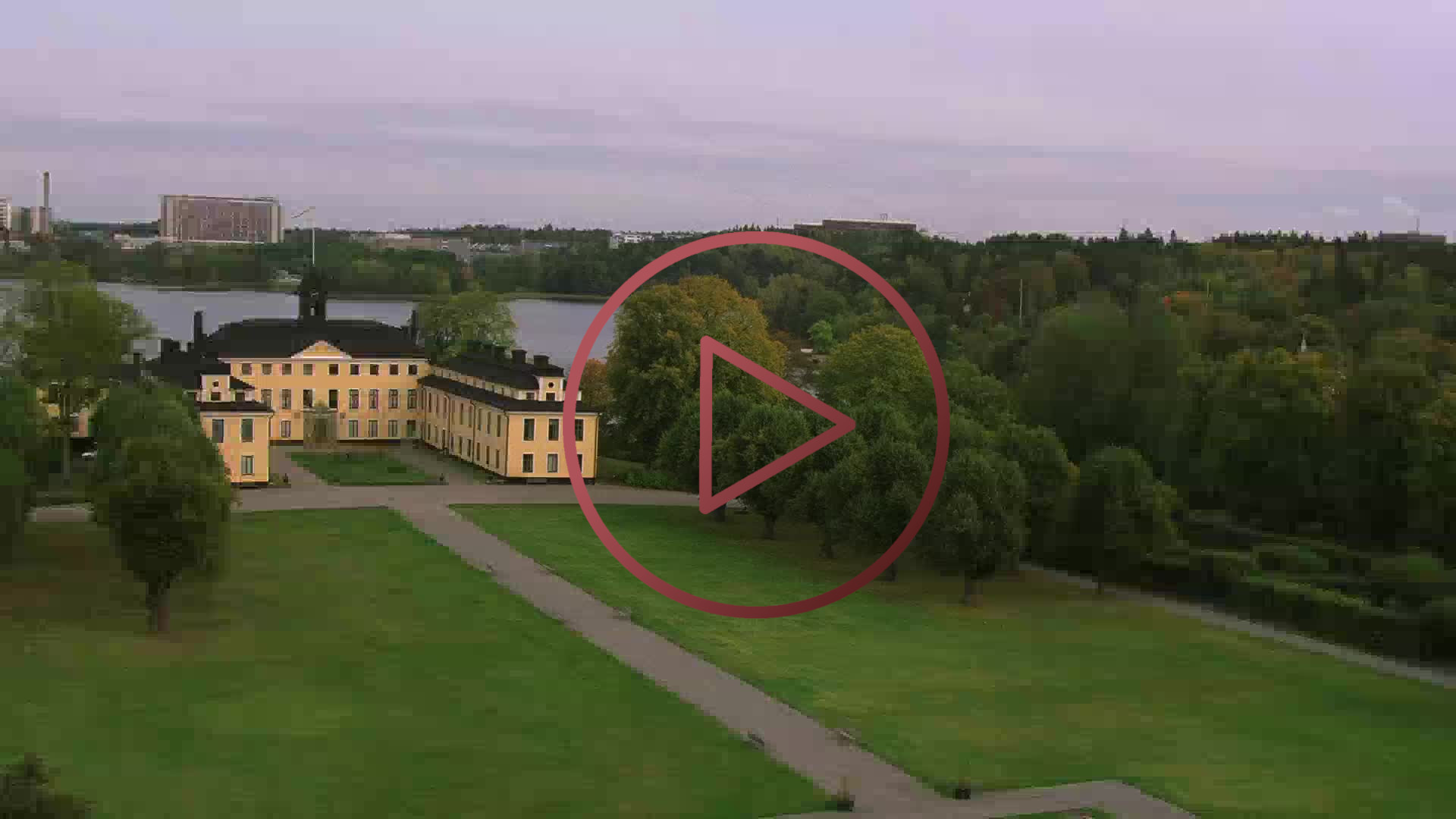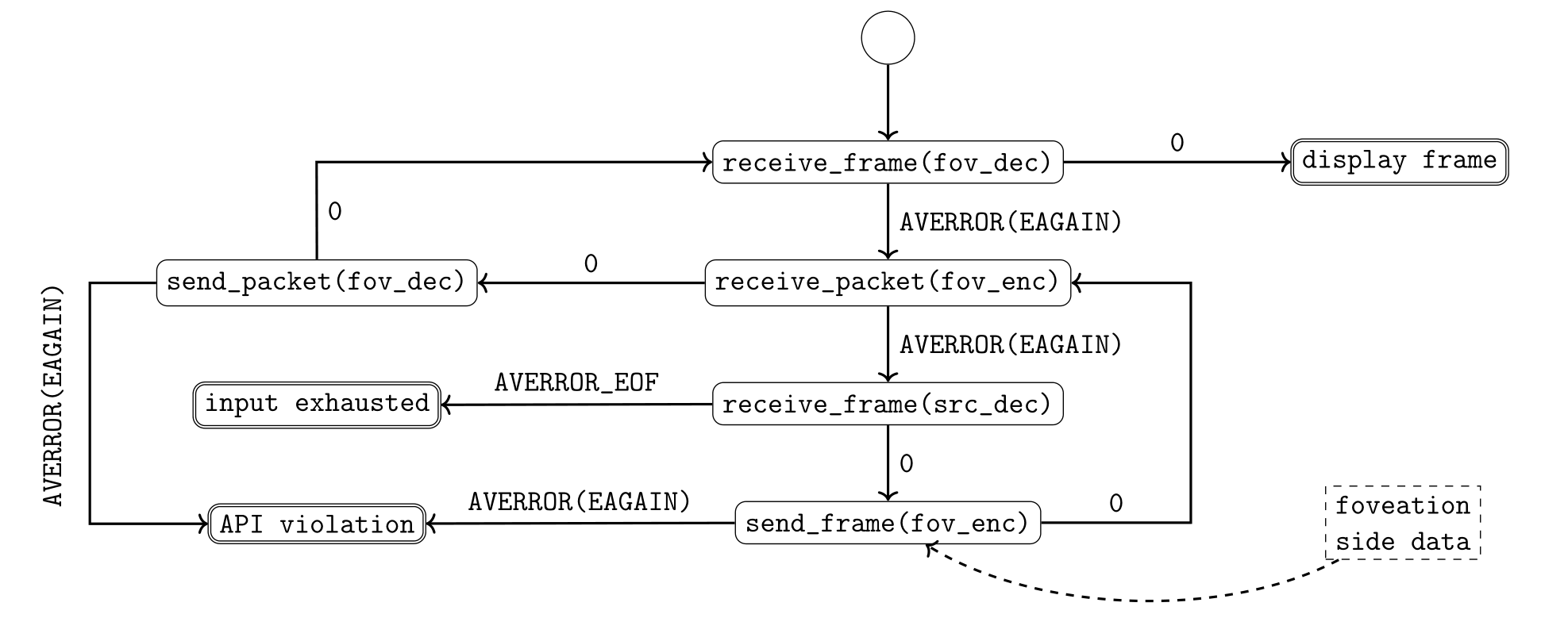A workbench for developing and researching foveated video codecs and applications.
The acuity of the human eye rapidly decreases outside of a circular region that covers roughly 2.5° of visual angle around the current center of fixation. We are limited to perceive imagery in the periphery at a significantly reduced resolution due to the density of photoreceptive cells on the retina. A concise introduction to the biological background can be found in Foundations of Vision by Brian A. Wandell, Vision Imaging Science and Technology Lab, Stanford.
Click on the image below for a short 1080p demo clip (~1.5M) that was compressed using x264:
The fixation point is set to be at the center of each frame, thus the visual quality decreases towards the periphery. The corners are already quite severely degraded and e.g. block flicker effects are clearly visible. This is intentional to showcase the effects of foveated encoding. In practice, one would ideally use feedback from an eye-tracker to steer the compression according to an observer's gaze in real time, which ideally renders these impairments invisible.
The graphic below displays a conceptual schematic of FFoveated.
Central part is the "foveated encoder", which takes input either directly from some sort of live source, e.g. a camera or the display buffer of some render engine, or as a raw frame sequence from a previously decoded file. The latter is useful to repeatedly evaluate this approach with different codec parameterizations. Its possible and intended to detach the dashed rectangle, which contains the "client side" from the encoder through a network connection.
This is implemented as a multi threaded feed-forward structure with tightly synchronized FIFO buffers.
From the display thread's perspective, requesting a frame from the decoder
results in the following (theoretical) stategraph, which is determined due to the
AVFrame/AVPacket handling in FFmpegs send/receive encodng and decoding API:
The worst non-erroneous case is that a frame is to be displayed and this graph
fails through all availability checks up until the reader has to demux and supply
a compressed AVPacket to the source decoder first. Depending on codec choices,
this can lead to multiple cycles of en- and decoding first, before a frame is
ready to be displayed - thus the asynchronously threaded buffer model presented
above.
TODO: Complete README.
Building FFoveated is slightly inconvenient - enhancing this process is on the
todo list. However, the two main components of this project are found in the
ffmpeg-foveated/ and src/ directories.
The project is pretty tame dependency wise should build on most Linux installations right out of the box, you'll just need
- libsdl2
To be able to use the provided eye-tracking implementation you need the iViewX SDK, which was originally distributed with scientific eye-tracking hardware by Sensomotoric Instruments, now known as Gaze Intelligence. I'm unable to share their their libraries and it wouldn't be much use to you anyways without one of their devices.
Alternatives should be easy enough to integrate, as long as you can determine fixation point positions in terms of pixels on the screen you're good to go.
The subtree in lib/ffmpeg-foveated contains a patched fork of
FFmpeg. If you already have FFmpeg installed
on your system you can probably save time by disabling more compilation
targets, however, this might lead to compatibility issues.
The following lines will configure and build the required shared libraries:
cd lib/ffmpeg-foveated/
./configure --enable-avcodec --enable-gpl --enable-libx264 --enable-shared --enable-debug --libdir=../../src/avlibs
make install-libsBuilding FFoveated itself is very straight forward. Just call make in src/.
Make sure to point your linker to these patched FFmpeg libraries.
Setting the LD_LIBRARY_PATH environment variable is a
temporary way to override the system libraries:
export LD_LIBRARY_PATH="/path/to/FFoveated/src/avlibs"you can check that the linker uses the correct files with ldd:
ldd main
linux-vdso.so.1 (0x00007ffc73155000)
libavutil.so.56 => /path/to/FFoveated/src/avlibs/libavutil.so.56 (0x00007fa28fdf3000)
libavcodec.so.58 => /path/to/FFoveated/src/avlibs/libavcodec.so.58 (0x00007fa28e8e1000)
libavdevice.so.58 => /path/to/FFoveated/src/avlibs/libavdevice.so.58 (0x00007fa28e8c7000)
libavformat.so.58 => /path/to/FFoveated/src/avlibs/libavformat.so.58 (0x00007fa28e676000)
libavfilter.so.7 => /path/to/FFoveated/src/avlibs/libavfilter.so.7 (0x00007fa28e2f7000)This is a rather niche project that aims to optimize high quality, low bandwidth video streaming applications with a single observer. Prominent use cases are:
- cloud gaming, where prerendered content is served via a network
- controlling of remote controlled vehicles/drones
There are better methods available for broadcasts and on-demand streaming. Even videotelephony probably allows for enough buffering to employ codecs relying on more a thorough content analysis, which has undeniable benefits over requiring a feedback-loop with an eye-tracker.
This work was used, mentioned or utilized in the following papers:
- O. Wiedemann, V. Hosu, H. Lin and D. Saupe, "Foveated Video Coding for Real Time Streaming Applications",
12th International Conference on Quality of Multimedia Experience (QoMEX), IEEE, 2020. PDF - O. Wiedemann and D. Saupe, "Gaze Data for Quality Assessment of Foveated Video",
Workshop on Eye Tracking for Quality of Experience in Multimedia (ET-MM) at ACM ETRA, Stuttgart, 2020. PDF
If you're interested in this project or related work have a look at my personal and group websites or drop me an email.



